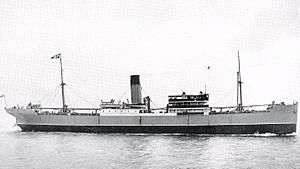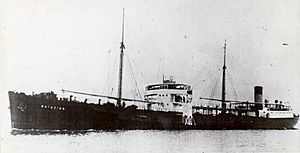United Africa Company facts for kids
| Subsidiary of Unilever | |
| Industry | Import & Export Trading, Shipping, Palm Oil plantations |
| Founded | 1929 |
| Defunct | 1987 |
| Headquarters | London, United Kingdom |
|
Area served
|
West & Central Africa |
|
Key people
|
Sir Arthur Edward Dyson, Sir Robert Whaley Cohen, Lord Trenchard, Frank Samuel & Sir Arthur Smith |
| Parent | Unilever |
The United Africa Company (UAC) was a British company that mainly traded in West Africa during the 20th century.
The United Africa Company was created in 1929. It was formed when two big companies, The Niger Company and the African & Eastern Trade Corporation, joined together. The Niger Company had been owned by Lever Brothers since 1920. In the early 1930s, UAC almost went broke. Because of this, it came under the control of Unilever. Unilever itself had just been formed in 1929 from the merger of Lever Brothers and a Dutch company called Margarine Union. The United Africa Company remained a part of Unilever until 1987, when it became fully absorbed by its parent company.
Contents
Leaders of the Company
- 1929–1931 Sir Robert Whaley Cohen
- 1936–1953 Lord Trenchard
- Frank Samuel
- 1969 Sir Arthur Smith
The Company's Ships
Why UAC Needed Ships
William Hesketh Lever was famous for making soap. He got involved in trade in West Africa to get palm oil for his soap factories.
In 1916, Lever bought a company called H. Watson & Co. This company had eight ships. Lever named this small group of ships the Bromport Steamship Company Ltd. Their ships had names like Colemere and Delamere.
During the last two years of the First World War, the Bromport Line lost half of its ships. German U-boats sank them.
In 1920, Lever bought the Royal Niger Company. But soon after, the West African trade market crashed. The price of palm kernel oil dropped a lot. By 1923, Lever Brothers decided to stop owning deep-sea ships because it was losing money.
Meanwhile, in 1923, the African & Eastern company started its own fleet of ships. They bought and renamed several steamers. In 1925, African & Eastern ordered its first new ship, the Nigerian. In 1928, they got another new ship, the Lafian. The Niger Company also started its own fleet by buying a ship called Tyria, which they renamed Ars.
Building a Bigger Fleet
When the United Africa Company was formed in 1929, it had five ships. Many trading companies in West Africa had owned their own ships for a long time.
The West African trade needed many smaller ships instead of a few very large ones. This was because deliveries had to be frequent, and there were many ports to visit. Since UAC was a large new company, its shipping business had a better chance to succeed. UAC quickly started to make its fleet bigger.
Between 1930 and 1934, UAC bought seven more used ships. The largest was the Lagosian. These ships were named after countries or ports they served, like Mendian and Zarian.
UAC expanded its fleet again in the 1930s. This was partly because trade was getting better. Also, Unilever had a lot of money stuck in Germany that the German government wouldn't let them take out. However, they could use this money to build ships in Germany. So, UAC started a new ship-building program in 1934. The first ship from this program, the Ashantian, joined the fleet in 1935.
As new ships were built, most of the older, used ships were sold. By 1938, the launch of the Lafian and Zarian marked the end of this big building program.
When World War II started in September 1939, the British government immediately took control of all 16 UAC ships for the war effort.
UAC Ships in September 1939
| Ship | Built | Type | GRT | Notes |
|---|---|---|---|---|
| SS Lagosian | 1928 | General Cargo | 5,449 | |
| SS Dahomian | 1929 | General Cargo | 5,277 | Built in 1929. Sold to UAC in 1933. |
| SS Warrian | 1929 | General Cargo | 1,057 | Used for African coastal services. Sunk in a collision in 1941. |
| SS Ashantian | 1935 | General Cargo | 4,917 | |
| SS Kumasian | 1935 | General Cargo | 4,917 | |
| SS Guinean | 1936 | General Cargo | 4,900 | Built in Germany. |
| SS Liberian | 1936 | General Cargo | 5,129 | Built in Germany. |
| SS Nigerian | 1936 | General Cargo | 5,423 | Built in Germany. |
| SS Leonian | 1936 | General Cargo | 5,419 | Built in Germany. |
| SS Ethiopian | 1936 | General Cargo | 5,424 | Built in Germany. |
| SS Matadian | 1936 | Bulk Vegetable Oil Carrier | 4,275 | |
| MV Congonian | 1937 | Bulk Vegetable Oil Carrier | 5,065 | Built in Germany. |
| MV Gambian | 1937 | General Cargo | 5,457 | Built in Germany. |
| MV Takoradian | 1937 | General Cargo | 5,599 | Built in Germany. |
| SS Conakrian | 1937 | General Cargo | 4,876 | |
| SS Lafian | 1937 | General Cargo | 4,876 | |
| SS Zarian | 1937 | General Cargo | 4,876 |
Ships During Wartime
UAC ships played an important role during World War II. They faced many dangers, including attacks from German submarines (U-boats).
The Guinean was one of the first UAC ships to be involved in the war. In June 1940, it helped evacuate British soldiers from France.
Some ships were lucky to survive attacks. The Zarian was hit by a torpedo in June 1940 but was towed to safety and repaired. However, other ships were lost. The Lagosian was bombed in September 1940, and the Congonian was sunk by a torpedo in November 1940.
Some ships were captured. The Takoradian and Gambian were taken by French officials in Dakar in July 1940 and were not released until 1943.
Losses at sea continued. In August 1941, the Kumasian was sunk by a torpedo off the Irish Coast. Most of the crew were rescued.
In September 1941, the Lafian was sunk by a U-boat. The captain of the Lafian described how his ship was hit and how the crew safely escaped into lifeboats before the ship sank. All crew members and passengers were rescued by a British ship.
The Nigerian was sunk by a torpedo near Trinidad in December 1942. Four crew members and one passenger died. Some passengers were taken prisoner by the submarine.
The Zarian, after being repaired, was torpedoed and sunk again in December 1942, with four lives lost.
In March 1943, the Lagosian, which had also been repaired after an earlier attack, was finally sunk by a torpedo near the Canary Islands. Eleven people died.
The worst tragedy for the fleet during the war happened in April 1943. The Ashantian was torpedoed and sank very quickly, leading to the loss of 16 crew members, including the captain. This ship had survived an earlier torpedo attack in 1940 and had been repaired.
The crew of the Matadian were fortunate when their ship was attacked and sunk in March 1944. They were close to shore and were rescued by Royal Navy boats.
The Dahomian was the last UAC ship to be lost, sunk by a torpedo off South Africa in April 1944. Two crew members died.
Out of the 16 ships UAC had at the start of the war, nine were sunk. Five of the remaining seven were damaged. Only two ships, the Leonian and Ethiopian, were not harmed. In total, 46 lives were lost from UAC ships during the war.
During the war, UAC tried to replace its lost ships by building three new ones: the Congonian (1942), the Kumasian (1943), and Lafian (1943). By 1945, UAC had only 10 ships left.
The End of the Fleet
After the war, in 1947, UAC bought three new ships named Ashantian, Lagosian, and Zarian. The next year, they added two more ships: the Nigerian and a tanker called Matadian.
These new ships brought the fleet up to 15 vessels. However, UAC realized that its shipping business would work better as a separate company. This new company could operate like other shipping lines and not just for UAC's own goods. So, in 1949, UAC created a new company by renaming an old one. This new company was called Palm Line.
Images for kids
See also
 In Spanish: United Africa Company para niños
In Spanish: United Africa Company para niños








